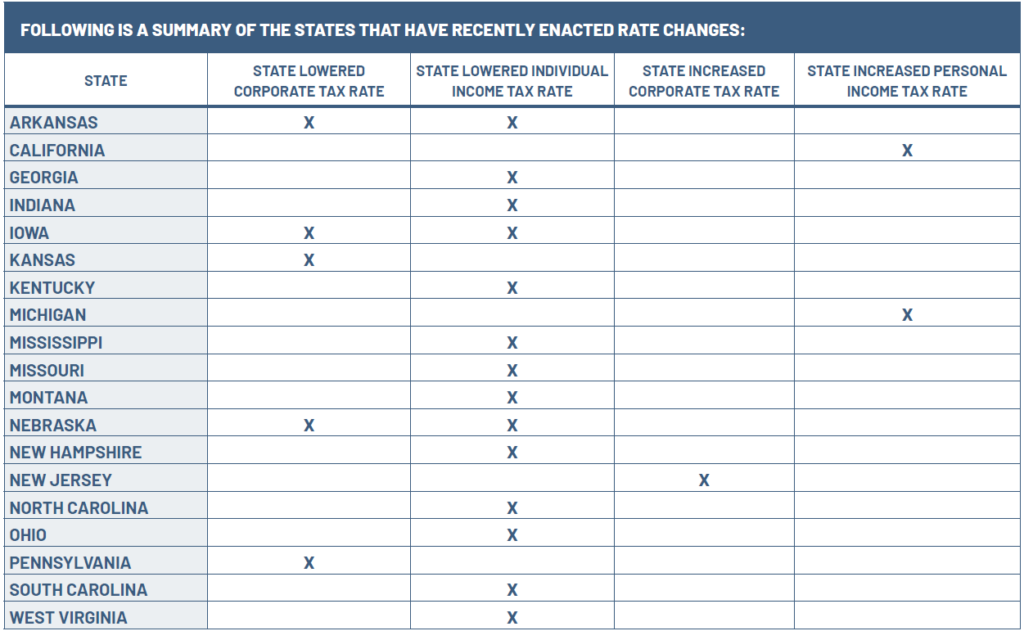Now that the dust has started to settle on post-Wayfair sales tax nexus requirements, states are switching their sales tax efforts to finding ways to expand the sales tax base. With economic nexus standards now firmly in place, the focus is on broadening the scope of things that are subject to tax such as software, services and digital advertising.
In addition, while the U.S. Supreme Court in Wayfair addressed only sales tax nexus, states are applying economic nexus standards for both sales tax and income tax.

In 2023, New Jersey became the first state to officially adopt the economic nexus standard (i.e., $100,000 sales or 200transactions) for both corporation business taxes and sales taxes.
Economic nexus presents risk and opportunity for taxpayers. States use differing sourcing rules and methodologies to assign sales to a particular state for multistate businesses. Although a business might have economic nexus in a state, with proper planning, income tax burdens can be alleviated or reduced with a sales-sourcing analysis, which ensures sales are correctly apportioned among the states. As states continue to adopt single-factor sales apportionment coupled with market-based sourcing, many businesses are actively reexamining their sales sourcing approaches to reduce state taxes.
SALT Deduction Limitation Workaround
- The majority of states have now passed legislation to circumvent the $10,000 state and local tax (SALT) deduction limitation (36 states in total including NJ and NY). In addition, New York City is allowing eligible entities to circumvent the SALT deduction limitation for taxable years beginning on or after January 1, 2022.
- The IRS has confirmed that pass-through entity tax (PTET) elections are effective workarounds to the SALT deduction limitation and allow businesses to fully deduct state and local taxes from their taxable income.
- State income tax refunds related to PTETs may create taxable income at the federal level. Careful consideration and planning should take place when electing PTET payments and the impact of individual withholding and estimated tax payments.
- In addition, the implementation of these new provision by the states has not been smooth. For example, New York has been sending out Notices to taxpayers disallowing the taxpayer’s credit for taxes paid to other states because, according to the Notice, the PTET tax that was imposed in the other state was not substantially similar to the New York PTET. Taxpayers receiving these Notices should examine them carefully because they may have been issued in error.
State Tax Credits
- State and local governments offer a variety of tax credits and incentive programs aimed at attracting businesses, stimulating investment, and retaining businesses currently operating within their borders. If your business is growing, or you are thinking about relocating, it is important to closely examine what credits and incentives may be applicable if making a large capital investment in a state or increasing your employee count in a state.
- Determining the best market for your business to incorporate and/or operate is a critical decision — do not overlook the tax credits and incentives that may be available. The credits may result in sufficient tax savings to sway the determination of whether to stay in a current location or move to a new one.
- Common opportunities from states and/or localities may target:
- Small and mid-size businesses
- Innovative businesses
- Job creation
- Capital investments
- Geography, such as distressed zones, enterprise zones, or tax-increment finance districts
- Specifically targeted industries, such as technology, manufacturing, agriculture, or film
- Angel investors
- Energy credits
- Not-for-Profits
2024 Year-End Tax Planning Resources
Now’s the time to review your year-end tax planning options and strategies for the 2024 tax season. Withum’s Year-End Tax Planning Resource Center offers tips, legislative updates, and tax-saving opportunities for individuals and businesses.
Sales and Use Tax Planning Considerations
With economic nexus here to stay, sales and use taxes are likely a significant financial burden for multi-state businesses if proper procedures are not in place and appropriately maintained. The issues of taxability review, the use of marketplace facilitators, and exemption certificate management have garnered more analysis in a post-Wayfair world.
Companies should regularly review their sales and use tax process and procedures, including, but not limited to:
Nexus
- Physical presence and economic nexus for sales tax purposes should be reviewed throughout the year to identify jurisdictions where additional collection and self-assessment responsibilities may exist.
- Understanding where your business has sales tax nexus is essential for complying with state and local tax laws. Failing to collect and remit the appropriate sales tax can result in significant tax liabilities, plus penalties and other legal issues.
- Without knowing where you have nexus, you may inadvertently accrue tax liabilities in multiple jurisdictions. Identifying your nexus creating activities allows you to calculate and collect tax from customers when applicable, and pay the correct amount of sales tax to avoid penalties and interest. There can be serious consequences to a business not knowing where it established nexus since several states have formed nexus units to search for non-compliant businesses.
- Identifying sales tax nexus helps streamline your business operations. You can implement accurate tax collection procedures, reduce the administrative burden, and catch potential errors in tax calculations.
- Tax authorities may audit your business to ensure compliance. If you know where you have nexus and maintain accurate records of collected taxes, the whole audit process is much smoother and less stressful.
- A business that works in the digital environment should closely monitor state developments regarding the taxability of items such as Software as a Service (SaaS), digital advertising and other online services, as states are eyeing these as potential sources of new revenue,
- Remote retailers, marketplace sellers, and marketplace facilitators should review if they are compliant with state and local sales and use tax laws and marketplace facilitator rules as states have new tools to address the taxation of these type of sales and are aggressive in using them.
- Companies should review their sales and use tax reserves and disclosures under ASC 450 to verify potential liabilities are properly accounted for.
Changing Tax Laws and Definitions
- Most state sales tax statutes were written decades ago, prior to the advent of the internet. These tax statutes may no longer be adequate to address the digital economy. States are addressing these inadequacies by updating regulations and statutes. For example, Texas has recently updated its rules on data processing to address computerized services.
- State definitions of taxable digital goods and services and cloud-based products are constantly evolving — and digital goods and services that were previously exempt are now taxable in several states. Maryland has been litigating its tax on digital advertising for several years and if it ultimately wins other states are certain to follow.
The following states have proposed sales tax legislation related to on streaming services.
| MASSACHUSETTS | H.4631/S.2771 (2024): Establish a comprehensive statewide policy concerning streaming entertainment services and the recovery of municipal costs for the management and maintenance of digital infrastructure by imposing a 5% gross receipts tax from the sale or provision of streaming entertainment services. |
| MICHIGAN | HB 4965 (2023): Amends the Uniform Video Services Act to provide that the term video services does not include direct-to-home satellite services or streaming content and to specify that it only includes services provided by a video service provider. |
| MISSOURI | HB 2057/SB 872 (2024) (enacted): Modifies provisions relating to video services subject to franchise fees to explicitly exclude all streaming services. |
| NEW YORK | AB 5900/SB 2581 (2023): Establishes a 5% excise tax on direct broadcast satellite services to fund the community media investment fund and video streaming services. |
| VIRGINIA | HB 30/SB 30 (2024): Imposes sales tax on several services including software application services, computer-related services, website hosting and design, data storage; and streaming services for personal consumption (i.e., business-to-business exemption). |
| VERMONT | SB 181 (2023): Imposes a 5% tax on the gross sales of streaming entertainment providers. |
Any time a business launches a new product or service line, it should perform a taxability analysis and review recent state tax developments regularly. For example, states like New York have been pushing the limits on what qualifies as taxable software or taxable digital services, (e.g., information services, data processing), which can potentially impact a company’s tax liability.
Compliance
- Companies should review their people, processes, and technology to identify how to comply with sales tax responsibilities in multiple states and localities.
- It may be necessary to implement third-party software to help maintain accurate sales tax rates and apply the proper sales tax to invoices. Note it’s important to verify the proper tax codes are selected in the third-party software because the invoices could be improperly calculating sales tax on your invoices to customers.
- The volume of state and local tax-related forms and deadlines can require significant time for employees to properly manage the sales and use tax functions. Errors could lead to substantial penalties, interest, or even liens on the responsible officer’s properties.
- As such, companies should consider outsourcing their sales and use tax compliance to reduce risks and concentrate on higher-value activities.
- Please note sales tax could be a significant factor in the event of a merger, acquisition, or request for funding. If the sales tax function is not reviewed periodically, a due diligence review may uncover exposures. Therefore, companies should periodically perform a review of their sales and use tax procedures.
Refunds
- Many vendors are conservative when applying sales taxes to purchases of products and services to be competitive in the market.
- Exemptions for certain purchases may provide opportunities for significant recoveries of sales and use taxes erroneously paid to vendors or accrued and remitted to a jurisdiction.
- An annual review of purchases should be conducted to identify potential refunds because some vendors may have not charged sales tax in error.
- In addition, new refund opportunities may exist because of the determinations in recent state tax court cases.
State and Local Income Tax Planning Considerations
A business should be considering state and local income tax nexus and sales sourcing assessment, if:
- Revenue streams are derived from multi-state customers/clients
- Business receipts are sourced due to varying state rules, based on the following:
- Location where services benefit the customer
- Location of customer’s billing address
- Location of customer’s headquarters
- Location of customer’s primary interaction/contacts with the business
- Location of customer’s order location
- Location of the customer’s customer (i.e., ultimate customer), or
- Other metrics (e.g., IP address analysis) that could result in a varied sourcing approach
- Sales could be subject to special industry sourcing rules, such as financial services, publishing, broadcasting, technology (e.g., SaaS, data processing), advertising, and transportation
- The business has significant tax in any out-of-state jurisdiction
States Are Generally Lowering Tax Rates
Several states have recently enacted corporate or personal income tax rate changes. While the majority of state statutory rate changes have lowered tax rates for individuals and businesses, California enacted the nation’s highest personal income tax rate (14.4%) and New Jersey enacted the Nation’s highest corporate income tax rate (11.5%). Companies should review Deferred Tax Asset estimates to determine if state income tax rate changes will affect those calculations.

Recent Income/Franchise Tax Nexus Developments
In the aftermath of Wayfair, the Multistate Tax Commission (MTC) has targeted one of the remaining legal barriers that businesses have to shield themselves from state assertions of income tax economic nexus – P.L. 86-272.
On August 4, 2021, the MTC voted to adopt a revision to its “Statement of Information” whereby a business could lose P.L. 86-272 protection solely by engaging with customers through the internet. In 2022, New York and California issued guidance that they were adopting the MTC’s revised Statement of Information. Currently, there are legal challenges to the adoption of the MTC guidance in both states. The taxpayer was recently successful in overturning the state’s adoption of the MTC guidance in California; however, the case was decided on procedural grounds and the court did not reach the question of whether the MTC guidance violate federal law. Other legal challenges are sure to follow.
Effective July 31, 2023, New Jersey adopted the MTC’s P.L. 86-272 revisions. It is expected many other states may adopt the MTC’s guidance implicitly through their MTC conformity provisions. The loss of P.L. 86-272 protection may result in additional income tax filing obligations for many businesses. The federal law known as P.L. 86-272 was passed over 60 years ago, and it prohibits a state from imposing a net income tax on businesses that only sell tangible personal property (TPP) and whose activities in a respective state do not exceed the solicitation of orders. For many years, even preceding the Wayfair case, for income tax, it has been generally accepted that economic nexus has been the law of the land unless a business was otherwise protected by limiting its activities to those outlined in P.L. 86-272.
The MTC’s Guide provides examples of when the use of an interactive website will exceed P.L. 86-272 Protection, including:
- Providing post-sale customer assistance via an electronic chat or website email
- A career or employment page that accepts applications for non-sales positions
- The use of “cookies” on a customer’s device to gather information on shopping trends or to track inventory
- Transmission of remote product patches, upgrades, or updates via the internet
- The offering of extended warranty plans
- Use of marketplace facilitators, such as the fulfillment center, which maintains inventory
- Other interactive internet-related activities
- The MTC’s revised statement adoption by multiple states could result in significant income tax liabilities for many remote businesses, as many of these businesses use a website or app to interact with their customers. Even if businesses have performed a nexus or P.L. 86-272 review in the past, they should consider having such studies refreshed, considering many of the developments over the last several years. Furthermore, the state application of the MTC rules is certain to be challenged. It is important to stay abreast of developments in this area. The MTC’s guidance greatly expands the list of activities that are not protected by P.L. 86-272 and it is likely that some state courts will reject the MTC’s interpretation of the federal statute. Furthermore, the state application of the MTC rules is certain to be challenged. It is important to stay abreast of developments in this area. The MTC’s guidance greatly expands the list of activities that are not protected by P.L. 86-272 and it is likely that some state courts will reject the MTC’s interpretation of the federal statute.
State and Local Tax Workarounds
One of the centerpiece provisions of the 2017 TCJA was the $10,000 cap on state and local taxes (SALT) that individuals (including pass-through businesses) could claim as an itemized deduction on their federal income tax returns. The SALT deduction limitation profoundly impacted many business owners and residents in high-tax states such as NJ, NY, CA, CT, and MA.
States responded by enacting pass-through entity taxes (PTETs) as a workaround to mitigate the impact of the SALT deduction limitation for the owners of pass-through entities. 36 states have enacted PTETs, making the availability of PTETs the rule rather than the exception. In theory, the utility of PTETs will cease on January 1, 2026, when the $10,000 SALT deduction limitation expires, but we anticipate that some states may retain their PTET elections in the event the SALT deduction limitation is extended or to bring AMT relief. A number of states linked their PTET rules to the TCJA rules. In the event that the TCJA sunsets, an analysis is required to determine which states will automatically continue their program versus a state that will require legislative action in order to continue their program.
Prior to making a pass-through entity election, there are several key issues that businesses need to consider:
- IRS Approval: The IRS indicated in Notice 2020-75 that it intends to allow PTETs. However, the IRS has not issued any further guidance on the issue.
- Federal Tax Benefit Implications: It is possible that the PTET benefit may be limited if some taxpayers are subject to the federal tax benefit rule.
- Resident Clients: Resident partners/shareholders participating in a PTET (elective or mandatory) may not receive a credit for taxes paid to another state on their resident state income tax return.
- Dual Estimate Payment Requirements: In some states, a passthrough entity needs to make estimated payments against the PTET. This may not alleviate the owners’ obligations to make estimated payments in their personal capacity. While the tax only gets paid once, this may cause cash flow issues from having to make two estimated tax payments.
- Refundability Issues: In most states, the PTET becomes a fully refundable credit on the owners’ personal income tax returns. However, in some states, the credit is not fully refundable, and/or excess credit is carried forward to future years, where it may expire if not fully used.
- Other Considerations: Business owners should keep in mind that the election to pay tax at the entity level is subject to each business’s facts and circumstances and may vary depending on specific state provisions. Additionally, the administrative cost of making a PTET (e.g., additional filings) may consume some of the savings.
Telecommuting
As the economy continues to evolve, widespread remote working and state budget shortfalls have increased the focus on state and local taxes. Although telecommuting raises many concerns, some of the central issues put into focus are:
- Income and Sales
- Tax Nexus Income Tax Apportionment
- State Payroll Withholding
Nexus, with respect to telecommuting, is generally straightforward. An employee’s presence in a state creates nexus unless the company is engaged in activities that are protected by P.L. 86-272. For income tax apportionment, in some states, the consequence of an employee working from a different state could affect sales sourcing, payroll, and the property factor. For example, the New York City UBT (for non-corporate entities) uses cost-ofperformance sourcing, which can lower taxes if employees leave New York to telework in nearby states. Such sourcing is generally determined based on where the services are performed.
Payroll withholding also presents challenges. Most states source employee wages to the state where the employee performs the services; however, with “Convenience of the Employer” rules, such as those in New York, there is added complexity. These rules, some of which preceded the pandemic, essentially require non-resident wages to be sourced to the state’s office where the employee is assigned, even if the employee works remotely in another state. The New York Division of Tax Appeals recently upheld the state’s implementation of the convenience of the employer rule but there will likely be more litigation to come on this issue.
This could result in double withholding requirements for the employer. Some of the key issues impacting payroll withholding decisions include:
- Temporary versus permanent employee relocations
- States that employ reciprocity agreements
- States with convenience of the employer rules
Employee mobility and telecommuting are here to stay, and businesses must adapt and plan for the many tax issues that arise.
Considerations for Changing Residency
Now that working from home has become more common, are you considering a move to another state? Perhaps to a low-tax or no-tax state? If so, you are not alone, and here are some of the things you should be considering for income tax purposes.
In order to change one’s domicile, an individual must physically move to a new jurisdiction with the concurrent intent to make the new jurisdiction their fixed and permanent home. Individuals domiciled in a state are subject to that state’s taxing authority on all their income. An individual who is required to pay tax as a nonresident in a state, even though they are domiciled elsewhere, is only subject to tax on income derived from sources originating outside his or her state of domicile (e.g., wages earned while working in a nonresident state, pass-through entity income).
Domicile is the place you regard as your permanent home — the place to which you intend to return after a period of absence (e.g., a vacation, a short-term business relocation, educational leave). As a practical matter, you can only have one domicile at any point in time, although you may have multiple residences. Once established, domicile continues until you affirmatively establish a new domicile.
Determining where an individual is domiciled requires a subjective analysis of several factors, including, but not limited to:
- The individual’s home (considering the size, nature, and use of the residences) when an individual maintains more than one home
- Active involvement in a trade or business in a state
- Where the individual spent the majority of their time (which is different than spending less than 183 days in a state)
- Location of “near and dear” possessions
- Family connections
Additional factors demonstrating an intent to permanently move include voter registration and obtaining a driver’s license and vehicle registration in the new state. The burden of proof is upon the person asserting a change of domicile. They must maintain sufficient records to demonstrate an intention to abandon their previous domicile and establish a fixed and permanent home in a new one. Proper planning and understanding of the residency rules in the states the taxpayer is leaving and moving to are critical for individuals contemplating a change of domicile.
Additional considerations when planning a change of domicile include:
- Whether an individual will remain subject to tax on their wages in the state they left pursuant to an Office of Convenience rule.
- Modeling potential tax savings by relocating to a low or no-tax state.
- Analyzing other costs associated with moving to a new state (e.g., real estate taxes, homeowners insurance premiums)
- Implementation of proper domicile planning, considering the facts and circumstances, documentation requirements, and other rules when putting in place a plan to mitigate audit risks.
- State Tax Authorities in high-tax states are aggressively examining taxpayers’ claims that they broke their domicile and demanding substantial documentation to back up the taxpayer’s assertions. Failing to prepare for a tax examination at the outset of a move jeopardizes the ability to ultimately prevail at the audit. Failing to plan = planning to fail.
State and Local Tax – Items to Consider
- Review existing and pre-Wayfair Nexus footprint including inventory held by marketplace facilitators
- Assess post-Wayfair filing obligations
- Evaluate income tax, sales and use tax, and other indirect tax nexus
- Determine potential tax exposure for prior periods
- Consider options to limit exposure (e.g., Voluntary Disclosure Agreements, amnesty, etc.)
- Assist with communication to stakeholders in the organization
- Review product and service mix
- Analyze sales sourcing of all revenue streams on a state basis for determining income tax nexus
- Develop nexus and taxability matrix
- Review purchases to identify potential sales tax refund opportunities
- Review and consider automation needs
- Prepare and file registrations as necessary
- Develop SALT processes to meet compliance requirements
- Prepare for tax audits
- Address changes in the organization (e.g., new lines of business, modified sales force activity, marketplace facilitator/provider inventory locations, etc.)
- Continue to monitor changes to economic nexus and tax laws
Contact Us
Reach out to a member of Withum’s State and Local Tax Services Team for guidance as year-end approaches.
Disclaimer: No action should be taken without advice from a member of Withum’s Tax Services Team because tax law changes frequently, which can have a significant impact on this guide and your specific planning possibilities.




